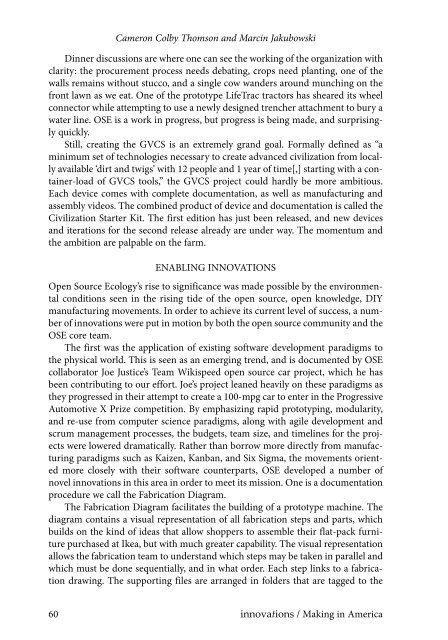Jakubowski-thomson
Jakubowski-thomson
Jakubowski-thomson
Create successful ePaper yourself
Turn your PDF publications into a flip-book with our unique Google optimized e-Paper software.
Cameron Colby Thomson and Marcin <strong>Jakubowski</strong><br />
Dinner discussions are where one can see the working of the organization with<br />
clarity: the procurement process needs debating, crops need planting, one of the<br />
walls remains without stucco, and a single cow wanders around munching on the<br />
front lawn as we eat. One of the prototype LifeTrac tractors has sheared its wheel<br />
connector while attempting to use a newly designed trencher attachment to bury a<br />
water line. OSE is a work in progress, but progress is being made, and surprisingly<br />
quickly.<br />
Still, creating the GVCS is an extremely grand goal. Formally defined as “a<br />
minimum set of technologies necessary to create advanced civilization from locally<br />
available ‘dirt and twigs’ with 12 people and 1 year of time[,] starting with a container-load<br />
of GVCS tools,” the GVCS project could hardly be more ambitious.<br />
Each device comes with complete documentation, as well as manufacturing and<br />
assembly videos. The combined product of device and documentation is called the<br />
Civilization Starter Kit. The first edition has just been released, and new devices<br />
and iterations for the second release already are under way. The momentum and<br />
the ambition are palpable on the farm.<br />
ENABLING INNOVATIONS<br />
Open Source Ecology’s rise to significance was made possible by the environmental<br />
conditions seen in the rising tide of the open source, open knowledge, DIY<br />
manufacturing movements. In order to achieve its current level of success, a number<br />
of innovations were put in motion by both the open source community and the<br />
OSE core team.<br />
The first was the application of existing software development paradigms to<br />
the physical world. This is seen as an emerging trend, and is documented by OSE<br />
collaborator Joe Justice’s Team Wikispeed open source car project, which he has<br />
been contributing to our effort. Joe’s project leaned heavily on these paradigms as<br />
they progressed in their attempt to create a 100-mpg car to enter in the Progressive<br />
Automotive X Prize competition. By emphasizing rapid prototyping, modularity,<br />
and re-use from computer science paradigms, along with agile development and<br />
scrum management processes, the budgets, team size, and timelines for the projects<br />
were lowered dramatically. Rather than borrow more directly from manufacturing<br />
paradigms such as Kaizen, Kanban, and Six Sigma, the movements oriented<br />
more closely with their software counterparts, OSE developed a number of<br />
novel innovations in this area in order to meet its mission. One is a documentation<br />
procedure we call the Fabrication Diagram.<br />
The Fabrication Diagram facilitates the building of a prototype machine. The<br />
diagram contains a visual representation of all fabrication steps and parts, which<br />
builds on the kind of ideas that allow shoppers to assemble their flat-pack furniture<br />
purchased at Ikea, but with much greater capability. The visual representation<br />
allows the fabrication team to understand which steps may be taken in parallel and<br />
which must be done sequentially, and in what order. Each step links to a fabrication<br />
drawing. The supporting files are arranged in folders that are tagged to the<br />
60 innovations / Making in America


